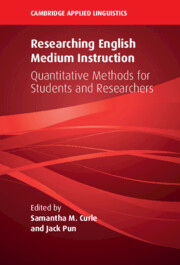Book contents
- Researching English Medium Instruction
- The Cambridge Applied Linguistics Series
- Researching English Medium Instruction
- Copyright page
- Dedication
- Contents
- Figures
- Tables
- Preface
- Acknowledgments
- Notes on Editors
- Notes on Contributors
- An Introduction to Researching English Medium Instruction Using Quantitative Research Methods
- Part I Theoretical Chapters
- Part II Empirical Chapters (Case Studies)
- 5 The Application of Partial Least Squares Structural Equation Modeling in Studies of EMI
- 6 Factor Analysis in Writing Research
- 7 Analyzing Questionnaire Data through Many-Facet Rasch Measurement: A Pilot Study of Students’ Attitudes toward EMI in the Chinese Higher Education Context
- 8 Questionnaire Development and Analysis in EMI Research
- 9 Effects of EMI on Learners’ Linguistic Development
- 10 Path Analysis of Science Learning in Hong Kong’s EMI Secondary Schools
- 11 Questionnaire Survey in Researching EMI
- 12 The Use of MANOVA in Analyzing the Effects of Gender on Perceived Difficulties in Speaking and Writing in a Hong Kong EMI University
- 13 Using a Longitudinal Quantitative Design to Investigate Student Transition from Secondary School to EMI Higher Education
- 14 A Corpus-Based Multidimensional Analysis of EMI University Classroom Discourse
- Index
- References
8 - Questionnaire Development and Analysis in EMI Research
A Study of EMI Learner Motivation and Attitudes
from Part II - Empirical Chapters (Case Studies)
Published online by Cambridge University Press: 14 December 2024
- Researching English Medium Instruction
- The Cambridge Applied Linguistics Series
- Researching English Medium Instruction
- Copyright page
- Dedication
- Contents
- Figures
- Tables
- Preface
- Acknowledgments
- Notes on Editors
- Notes on Contributors
- An Introduction to Researching English Medium Instruction Using Quantitative Research Methods
- Part I Theoretical Chapters
- Part II Empirical Chapters (Case Studies)
- 5 The Application of Partial Least Squares Structural Equation Modeling in Studies of EMI
- 6 Factor Analysis in Writing Research
- 7 Analyzing Questionnaire Data through Many-Facet Rasch Measurement: A Pilot Study of Students’ Attitudes toward EMI in the Chinese Higher Education Context
- 8 Questionnaire Development and Analysis in EMI Research
- 9 Effects of EMI on Learners’ Linguistic Development
- 10 Path Analysis of Science Learning in Hong Kong’s EMI Secondary Schools
- 11 Questionnaire Survey in Researching EMI
- 12 The Use of MANOVA in Analyzing the Effects of Gender on Perceived Difficulties in Speaking and Writing in a Hong Kong EMI University
- 13 Using a Longitudinal Quantitative Design to Investigate Student Transition from Secondary School to EMI Higher Education
- 14 A Corpus-Based Multidimensional Analysis of EMI University Classroom Discourse
- Index
- References
Summary
This chapter discusses how questionnaire-based research can be implemented in the English Medium Instruction (EMI) contexts. It presents an empirical study which that examined Chinese EMI university students’ attitudes and motivation (i.e., integrative and instrumental orientations) toward learning content subject knowledge in English. An EMI scale adapted from Gardner’s (2004) Attitude/Motivation Test Battery (AMTB), which takes the format of Likert-point scale as explained in Chapter 3 of the this book, was validated and administered to 541 EMI students from three Chinese universities. The validity and reliability of the scale were measured, the correlations of the three dimensions (i.e., attitudes, integrative orientation, and instrumental motivation) were tested, and the role of demographic variables (i.e., gender, level of study, disciplinary background) in EMI attitudes and motivation were explored. The research findings suggest the validity and reliability of the scale, the positive correlations among the three dimensions, and the different degrees of EMI attitudes and motivation between male and female students and between soft science and hard science students. The researchers argue that questionnaire-based research is appropriate for the EMI contexts, but its effectiveness can be enhanced if the mixed methods design is adopted.
- Type
- Chapter
- Information
- Researching English Medium InstructionQuantitative Methods for Students and Researchers, pp. 134 - 149Publisher: Cambridge University PressPrint publication year: 2024

